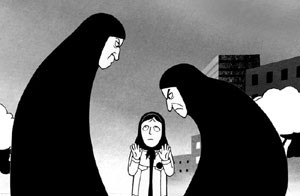As suspicious as one might be of the phrase after hearing it applied to every other animated film ever made, “”Persepolis”” is a genuinely magical film. With its gorgeous visual style – which suggests at times a shadow puppet show and at other times a charcoal drawing- it’s also that rare film that deserves to be called beautiful.
Marjane Satrapi is an ordinary 10-year-old girl who lives in Iran in the ’70s. She spends her days playing with her friends and pretending to be a revolutionary. She has a poster of Bruce Lee on her wall.
Then a real revolution comes, and Marjane finds herself cutting pictures of the once-revered shah out of her school textbooks. She becomes fascinated by forbidden Western music like Iron Maiden and the Bee Gees.
“”Persepolis””
Rated PG-13 – 95 mins.
2.4.7 Films
5 stars!
Eventually, Marjane’s attitude lands her in trouble at school, and her worried parents decide to send her to school in France. After a long spree of misadventures involving boys, drugs and cranky landlords, she winds up back home again, and finds Iran an increasingly stifling place to live.
The film, adapted from the real Satrapi’s acclaimed comic books (I use the term deliberately, since “”graphic novel”” summons up visions of those ultraviolent romps that seem to come out every six months), is like no other animated film you’ve ever seen. It utterly eschews the drearily predictable Disney style, but it’s also a far cry from the bland, cookie-cutter look of modern cartoons like “”Family Guy.”” The images in “”Persepolis”” – mostly black-and-white, with the exception of some framing scenes in color – melt and merge together like the visual elements of a dream. At the same time, the artwork is simple and stylishly stark, like an old “”Tintin”” book.
The film also sketches a fascinating picture of Iran through short but telling vignettes. Coming shortly after a period when it seemed all but certain that the United States was tumbling toward invading Iran, “”Persepolis”” is like a dash of cold water; it utterly contradicts many of the assumptions Americans have carried around for years about that faraway, feared country.
It’s a harsh tonic for anyone who harbors the vague belief that Iran is a “”democracy”” and thus free of injustice, but it also scrapes against the popular notion that Iranians are nothing but a mob of fundamentalist bigots who unquestioningly support their autocratic leaders. (Not surprisingly, Iran has already denounced the film as “”anti-Iranian.””)
Indeed, one of the most moving things about the film is how ordinary and recognizable its characters are. We all know people like Marjane, people as reckless yet admirable as her revolutionary-minded uncle, and people as unexpectedly brash as her brave and outspoken grandmother, who shrugs at the breakup of her granddaughter’s marriage: “”The first marriage is practice for the next one.”” But these characters are flung into circumstances that most of us would find intolerable.
It’s unclear if the film will have a sequel, but the story it tells is complete, so complete that the open-ended ending is not unsatisfying. As Marjane prepares to leave Iran behind again at the end of the movie, we feel the weight of her decision, and we too are torn between sorrow and relief. The first life was practice for the next one.









